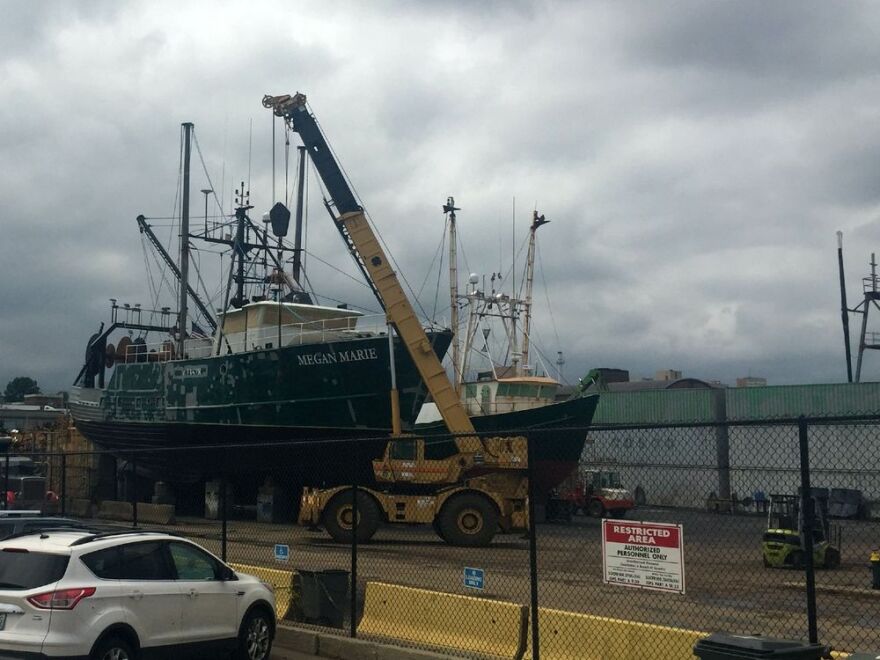New England commercial fishermen have one of the most dangerous jobs in the country. Now, they’re worried new offshore wind farms will make things worse. Construction is set to begin this year on the country’s first large scale offshore wind project. Most of the attention has focused on jobs and the economy, but the fishermen say they’re also worried about safety.
On most days, Daniel Farnham is on the dock of his father’s fishing boat, working alongside his crew that catches squid, whiting, and porgy off the coast of New Bedford.
But on this day, the 100-foot boat is out of the water at a metal recycling plant. Farnham is wearing a hard hat, protective glasses, and a safety jacket conducting the boat’s biennial maintenance check looking for rust and chipped paint.
Farnham has been working on the vessel for over four years and says nature’s elements aren’t kind to the boat or fishermen.
"My first real commercial trip was hurricane force winds and 20 foot waves," Farnham says. "But those are the conditions we operate in because these boats are meant to go out and work."

Fishing is one of the most dangerous jobs in the country. In 2017, over 40 fishermen died while navigating out at sea -- the highest rate of occupational deaths that year.
"[Fishing is] like trying to drive around in a car with no brakes," Farnham says. "on a road made out of treadmills and having obstacles thrown in your way continuously."
Farnham says offshore wind farms will make it worse. That’s because fishermen argue the turbines aren’t spaced far enough apart to allow vessels to safely navigate through them.
The plan is to install 84 massive turbines in a grid-like pattern about three-quarters to a nautical mile apart.
Farnham says mobile gear vessels like his, that have massive nets trawling behind them, will make it even harder to navigate.
The currents and the tides can take the boat in any direction "and so that's when you could wind up having a collision or an allision with one of the turbines or another vessel because everyone's maneuverability is a lot more limited," Farnham says.
Until now, safety has not been a major point at the negotiating table with Vineyard Wind. But as the offshore wind farm gets closer to becoming a reality, fishermen’s voices are getting louder.
Farnham is part of a fisheries working group. He’s hoping that safety will be addressed before the project is a done deal.
Fishermen in the group wants the turbines to be spaced farther apart or closer together so the wind farm takes up less space and the boats can just navigate around them. If that doesn’t work, fishermen want to be compensated more for potential safety losses.

Environmental economist Tom Sproul says there are reasons to be concerned about safety. Sproul evaluates risk, and his work has recently focused on the fishing industry. He projects offshore wind developments will contribute to maritime accidents that could cost millions of dollars in damage.
In May, Sproul wrote a letter to Massachusetts coastal zone management officials. He provided them with some rough economic calculations about the number of accidents they could expect once the wind farm is in operation.
"On average there will be three accidents over 30 years for the Massachusetts fishermen and about five for Rhode Island fishermen," Sproul says. "[That's] eight accidents that randomly happened over 30 years over thousands of fishermen."
Sproul says, statistically, the number of potential accidents could vary. "It could just as easily be 16 [accidents] over that 30 year stretch and it would not be statistically remarkable and it could be fewer as well." But his point is, "if any one of these does happen we start talking about much larger costs."
Those costs could be a loss of a vessel that could cost anywhere between $700,000 to $8 million, loss of income, or a loss of life. The number of accidents will depend on how fishermen react once the turbines are actually in the water.
"These things are complex," Sproul says. "We don't know how the vessels are going to respond [or] how they're going to reroute."
Vineyard Wind says it did its homework early on in the design process. It held over 100 meetings with fishermen or fishing organizations that work the waters in or around the wind farm area. And it analyzed vessel traffic data to find patterns in how fishermen operate.

Erich Stephens, Chief Development Officer for Vineyard Wind says the developer conducted a navigational risk assessment of the wind farm area that took lessons from the United Kingdom and other parts of the world.
"The determination was that it would allow for safe navigation," Stephens says.
The U.S. Coast Guard is evaluating Vineyard Wind’s risk assessment and will come out with its own report sometime this fall.
Stephens welcomes the scrutiny.
"It's in our interest developing this first project to make sure that everything that we've been saying proves to be true," Stephens says. "If we don't when we go to permit our project or when our competitors go to permit their projects, [regulators are] going to say, 'Look that [project] didn't happen the way it said [it would]."
Final permit approval for the Vineyard Wind project is in the hands of the Bureau of Ocean Energy Management.
Whatever happens here has the potential to affect, not just Vineyard Wind, but the fifteen active projects in the works across the Northeast. Which is why Farnham says getting it right the first time matters.
"It terrifies me to picture trying to drive through a forest of thousands of turbines," Farnham says.
He knows he’ll have to get used to working within wind turbines his entire career but, in the end, he may just do his best to avoid them. Better to be safe than sorry.




